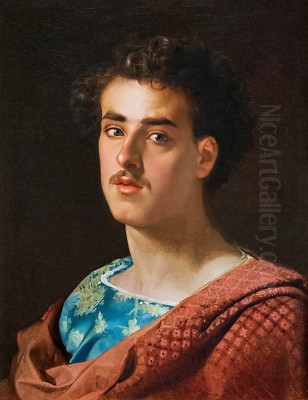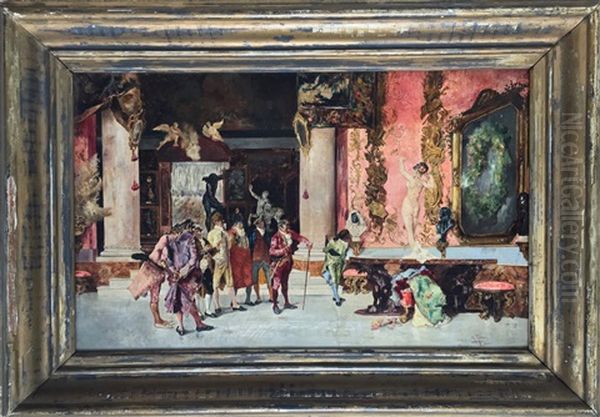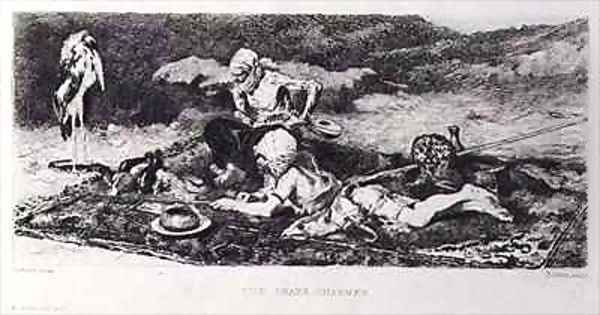
Mariano Fortuny y Marsal stands as one of the most dazzling figures in 19th-century European art. A Spanish painter, watercolourist, and etcher of prodigious talent, he achieved immense international fame during his relatively short life (1838-1874). Renowned for his technical virtuosity, brilliant handling of light and colour, and captivating depictions of Orientalist themes and historical genre scenes, Fortuny captivated audiences and collectors across Europe and America. Though his career was tragically cut short, his influence was profound, particularly in Spain and Italy, leaving behind a legacy of vibrant, meticulously crafted works that continue to fascinate.
Early Life and Artistic Formation
Mariano Fortuny y Marsal, whose full baptismal name was Marià Josep Maria Bernat Fortuny i Carbó, was born on June 11, 1838, in Reus, a town in Catalonia, Spain. Orphaned at a young age, his upbringing was overseen by his grandfather, a cabinet maker who also dabbled in wax figure modelling. Recognizing young Mariano's artistic inclination, his grandfather enrolled him in the local drawing school run by Domènec Soberano. He also received instruction from the sculptor Domènec Talarn, who created wax figures with him.
In 1852, Fortuny moved to Barcelona with his grandfather. There, he enrolled at the Escola Provincial de Belles Arts (the Llotja School), a prestigious institution where he studied under artists like Claudi Lorenzale and Pau Milà i Fontanals. These teachers were associated with the Nazarene movement, a German Romantic style emphasizing linearity and religious or historical themes, which likely provided Fortuny with a solid grounding in academic drawing. His talent was evident, and in 1857, he won a scholarship from the Barcelona Provincial Council, enabling him to travel to Rome to continue his studies.
The Roman Experience and Early Influences

Rome was the crucible where Fortuny's talent truly began to flourish. He arrived in 1858 and immersed himself in the study of the Old Masters at the Accademia Gigi. Like many artists before him, he was captivated by the art of the Italian Renaissance and Baroque periods. He spent time copying works in the Vatican and other collections, absorbing lessons from masters like Raphael and Michelangelo. However, he also looked closely at Spanish predecessors, particularly the dramatic realism and chiaroscuro of Jusepe de Ribera and the profound artistry of Diego Velázquez.
During his initial years in Rome, he painted historical subjects, fulfilling the requirements of his scholarship. He associated with other Spanish artists studying in the city, forming connections that would last throughout his career. This period was crucial for honing his technical skills and broadening his artistic horizons beyond the more rigid confines of his Barcelona training. Rome offered a vibrant international artistic community and exposure to a wider range of influences.
The Moroccan Campaign and the Dawn of Orientalism
A pivotal moment in Fortuny's career came in 1859-1860. The Barcelona Provincial Council commissioned him to travel to Morocco to document the Spanish military campaign (the Hispano-Moroccan War). This experience was transformative. Although tasked with creating large-scale historical battle paintings, Fortuny was far more captivated by the everyday life, vibrant colours, exotic costumes, and dazzling light of North Africa. He filled sketchbooks with drawings and painted numerous oil studies and watercolours capturing the landscapes, architecture, and people he encountered.
This trip ignited Fortuny's lifelong fascination with Orientalist themes. Unlike some French contemporaries such as Eugène Delacroix, whose Orientalism often carried a strong Romantic, sometimes violent, charge, or Jean-Léon Gérôme, known for his highly polished, almost photographic ethnographic detail, Fortuny's approach was characterized by an intense focus on light, texture, and decorative detail. He was less interested in narrative drama and more in capturing the visual richness and sensory experience of the environment. His Moroccan subjects became immensely popular, appealing to the European taste for the exotic.
He worked intermittently on the large commissioned painting, The Battle of Tetuan, for years, but it remained unfinished, perhaps because his true passion lay in smaller, more intimate studies of Moroccan life. Works like The Arab Chief or numerous depictions of street scenes, marketplaces, and figures in traditional attire showcase his developing style – brilliant colour, flickering light, and a combination of meticulous detail with passages of looser, more suggestive brushwork. He would return to North Africa later in life, reinforcing this crucial source of inspiration.
Life in Rome, Paris, and International Stardom

After his initial Moroccan trip, Fortuny returned to Rome, which remained his primary base for much of his life. In 1867, he married Cecilia de Madrazo, the daughter of the prominent Spanish painter Federico de Madrazo, director of the Prado Museum, and sister of the painter Raimundo de Madrazo y Garreta. This marriage connected him to one of Spain's most influential artistic dynasties and further integrated him into the upper echelons of the art world. His studio in Rome became a hub, filled with the textiles, ceramics, arms, armour, and objets d'art he avidly collected, which often appeared in his paintings.
Fortuny's international breakthrough came largely through Paris. He began exhibiting there and signed a lucrative contract with the influential art dealer Adolphe Goupil. Goupil marketed Fortuny's work brilliantly, particularly his small, highly finished genre scenes, often set in the 18th century or featuring exotic Orientalist motifs. These paintings, sometimes referred to as tableautins, were characterized by their jewel-like precision, dazzling technique, and charming subject matter.
His most sensational success was The Spanish Wedding (La Vicaria), completed in 1870. This painting depicts the signing of the marriage register in an 18th-century Spanish church sacristy. Its intricate detail, vibrant depiction of fabrics and textures, brilliant light effects, and lively cast of characters caused a sensation when exhibited at Goupil's gallery in Paris. It fetched an enormous price and cemented Fortuny's reputation as one of the most sought-after artists in Europe. Collectors, particularly wealthy Americans like William H. Vanderbilt and A. T. Stewart, eagerly acquired his works, often paying exorbitant sums.
Genre Scenes and Historical Settings
While Orientalism remained a key theme, Fortuny also excelled in genre painting, often with a historical flavour. These works frequently depicted scenes from the Rococo or 18th century, showcasing elegant figures in period costume within richly decorated interiors or gardens. Il Contino (The Young Count), a sparkling watercolour, is a prime example, depicting a young man in 18th-century attire before a grand monument.
These genre scenes shared similarities with the work of French academic painters like Ernest Meissonier, who also specialized in small, meticulously detailed historical reconstructions. However, Fortuny's paintings possessed a unique vibrancy and luminosity, a nervous energy in the brushwork, and a sensitivity to light that set them apart. He wasn't merely reconstructing the past; he was infusing it with his own dazzling technique and visual sensibility. His ability to render silks, satins, metalwork, and intricate patterns was unparalleled.
Mastery Across Mediums: Painting, Watercolour, Etching

Fortuny's technical brilliance was not confined to oil painting. He was an exceptionally gifted watercolourist, achieving a luminosity and intensity of colour rarely seen in the medium at the time. His watercolours often possess the richness and depth of oil paintings, demonstrating his innovative approach. He handled washes with fluidity while simultaneously employing fine detail, capturing fleeting effects of light and atmosphere with remarkable skill.
He was also a master etcher. Influenced by the works of Rembrandt and Francisco Goya, Fortuny developed a highly personal etching style characterized by dynamic lines, rich tonal contrasts, and a sense of immediacy. His etchings, often depicting similar themes to his paintings (Moroccan figures, genre scenes, studies of objects), were highly prized by connoisseurs and fellow artists. They reveal his superb draughtsmanship and his ability to translate his fascination with light and texture into the graphic medium. His exploration across these different mediums demonstrates his restless artistic curiosity and technical command.
Granada, Later Style, and Collecting
In the early 1870s, Fortuny spent considerable time in Granada, southern Spain. He was deeply inspired by the city's Moorish heritage, particularly the Alhambra palace. He painted numerous views of its courtyards and architectural details, such as El patio de la Alberca, Granada. This period seems to have coincided with a subtle shift in his style. While maintaining his characteristic attention to detail, some works from this time show a greater interest in broader effects of light and atmosphere, with looser, more broken brushwork, particularly in landscapes and outdoor scenes.
His unfinished painting, Beach at Portici (painted near Naples in 1874), is often cited as evidence of this evolving direction. It depicts figures relaxing on a sunny beach with a remarkable freshness and sensitivity to natural light, leading some critics to see parallels with the emerging Impressionist movement in France, spearheaded by artists like Claude Monet and Edgar Degas. However, Fortuny's path remained distinct; his work never fully embraced the Impressionist dissolution of form or their focus on contemporary urban life. His interest lay more in capturing the brilliance of light on surfaces and textures within carefully composed scenes.
Throughout his career, Fortuny was an avid collector. His Roman studio was famously crammed with antiques and exotic objects: Hispano-Moresque pottery, Islamic metalwork, ancient weapons, luxurious textiles, carpets, and furniture. These items were not mere props but sources of inspiration and study, reflecting his deep engagement with craftsmanship and historical aesthetics. This passion for collecting informed his art, lending authenticity and richness to his depictions.
Premature Death and Immediate Legacy

While at the height of his fame and artistic powers, Mariano Fortuny died suddenly in Rome on November 21, 1874, at the young age of 36. The exact cause of death remains debated among historians. Contemporary accounts often cited malaria or "Roman fever," common ailments in the city at the time. Some later sources suggested tuberculosis, while unsubstantiated rumours even hinted at complications from a duel or personal conflict, possibly involving the painter José Casado del Alis, though evidence suggests they were actually on good terms.
His death sent shockwaves through the international art world. His funeral in Rome was a major event. Initially interred there, his body was later repatriated to his hometown of Reus. His widow, Cecilia, and her family organized large, highly publicized auctions of the contents of his studio and his personal art collection in Paris (at the Hôtel Drouot in 1875) and Rome. These sales dispersed his works and collections widely, further solidifying his posthumous fame but also attracting some criticism regarding the handling of the estate.
Fortuny's immediate influence, particularly in Spain and Italy, was immense. A wave of imitators emerged, adopting his brilliant technique, detailed finish, and popular subject matter (Orientalist and genre scenes). This trend, sometimes dubbed "Fortunysmo" or "Fortunyism," dominated academic painting in these countries for a period, with artists like Joaquín Agrasot and José Villegas Cordero following closely in his footsteps. However, this very popularity eventually led to a backlash, with later generations criticizing the style as overly decorative and lacking in substance compared to the innovations of Realism or Impressionism.
Fortuny and His Contemporaries
Despite his international renown and time spent in Paris, there is no documented evidence of significant direct interaction between Fortuny and the leading figures of French Impressionism like Édouard Manet or Claude Monet. Their artistic circles and aesthetic goals, while overlapping in their interest in light, were largely separate. Fortuny operated more within the orbit of established academic figures and dealers like Goupil and Meissonier, and his closest artistic connections were with fellow Spanish artists (like the Madrazo family, Eduardo Rosales) and expatriates in Rome, or figures like the Belgian painter Alfred Stevens, who became his brother-in-law through marriage.
While some later works like Beach at Portici show a move towards capturing fleeting light effects that resonate with Impressionist concerns, Fortuny's overall approach remained rooted in detailed observation, meticulous finish, and often historical or exotic subject matter, distinct from the Impressionists' focus on modern life and optical sensations. He can be seen as a brilliant culmination of certain 19th-century trends – Romanticism, Orientalism, historical genre – rather than a direct participant in the avant-garde movements that would soon dominate the art scene. His technical virtuosity, however, was admired even by those pursuing different paths.
Fortuny's Works in Museums and the Market
Today, Mariano Fortuny y Marsal's works are held in major museum collections around the world. The Museo Nacional del Prado in Madrid holds a significant collection, including important paintings, watercolours, and drawings, and has organized major retrospectives of his work. The Museu Nacional d'Art de Catalunya (MNAC) in Barcelona also has a substantial holding. Other notable collections can be found at the Meadows Museum in Dallas (which acquired Beach at Portici), the Walters Art Museum in Baltimore, the Metropolitan Museum of Art in New York, and the Mitsubishi Ichigokan Museum in Tokyo.
The Palazzo Fortuny in Venice, once the home and studio of his son, Mariano Fortuny y Madrazo (a renowned designer in his own right), now functions as a museum often featuring exhibitions that include works by Fortuny père, highlighting the family's artistic legacy. Fortuny's works continue to appear on the art market, commanding high prices at auction, particularly his highly finished oil paintings and luminous watercolours, attesting to his enduring appeal to collectors.
Conclusion: An Enduring Brilliance
Mariano Fortuny y Marsal remains a captivating figure in 19th-century art history. His meteoric rise to fame, his extraordinary technical skill across multiple mediums, and his vibrant depictions of exotic lands and historical vignettes secured his place as one of the leading artists of his generation. While his style eventually fell out of fashion with the rise of Modernism, his work has undergone significant re-evaluation, appreciated anew for its sheer visual brilliance, its sensitivity to light and texture, and its unique blend of meticulous realism and painterly verve.
He represents a fascinating bridge between academic tradition and a more modern sensibility towards light and colour. Though his life was short, the intensity and quality of his output left an indelible mark. He brought a distinctly Spanish flair to the international art scene, mastering Orientalist and genre painting with a dazzling technique that few could rival. Distinguishing him from his equally famous son, the designer Mariano Fortuny y Madrazo, the painter Mariano Fortuny y Marsal stands as a testament to virtuosity and the enduring allure of exquisitely crafted images.